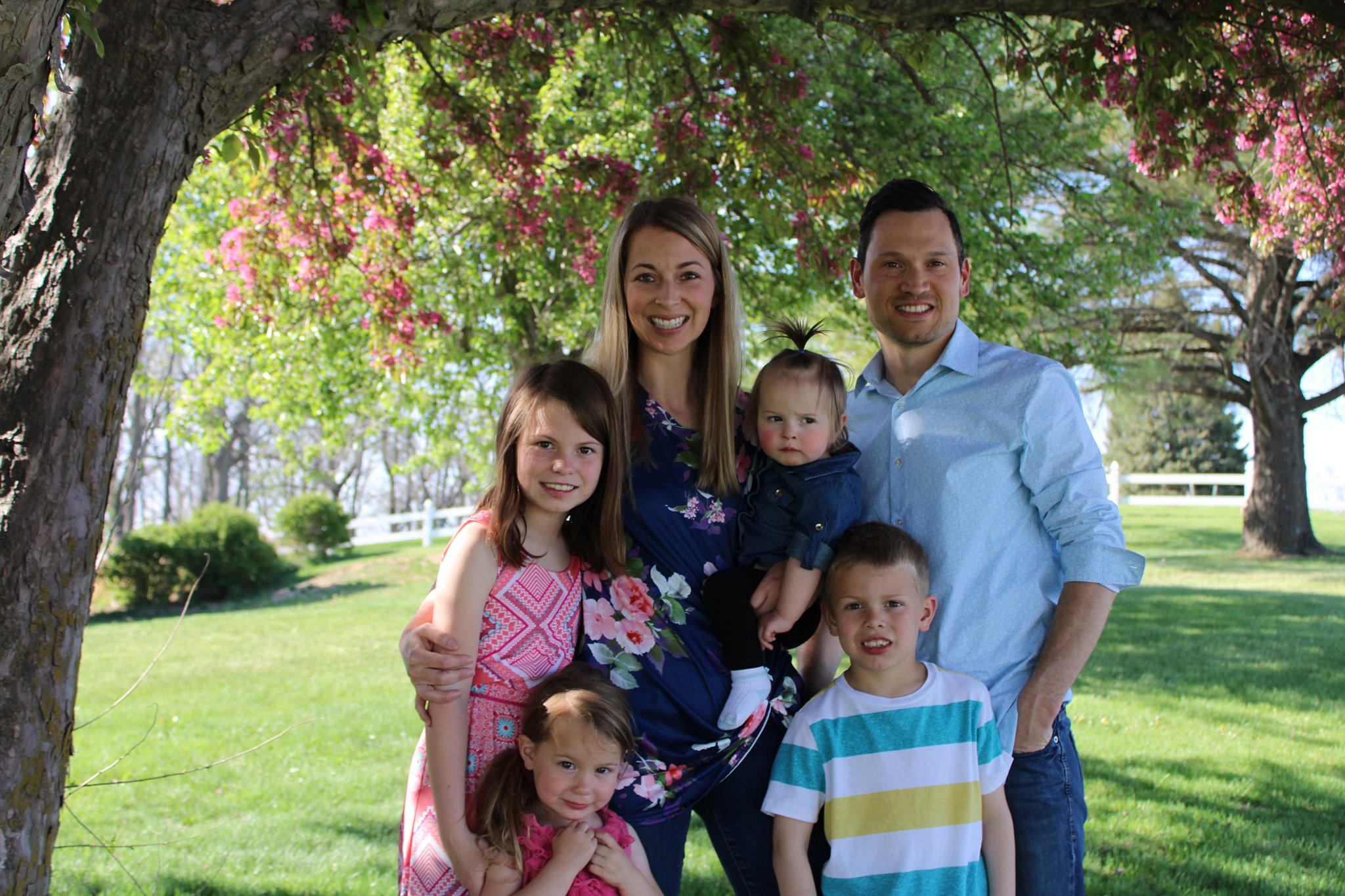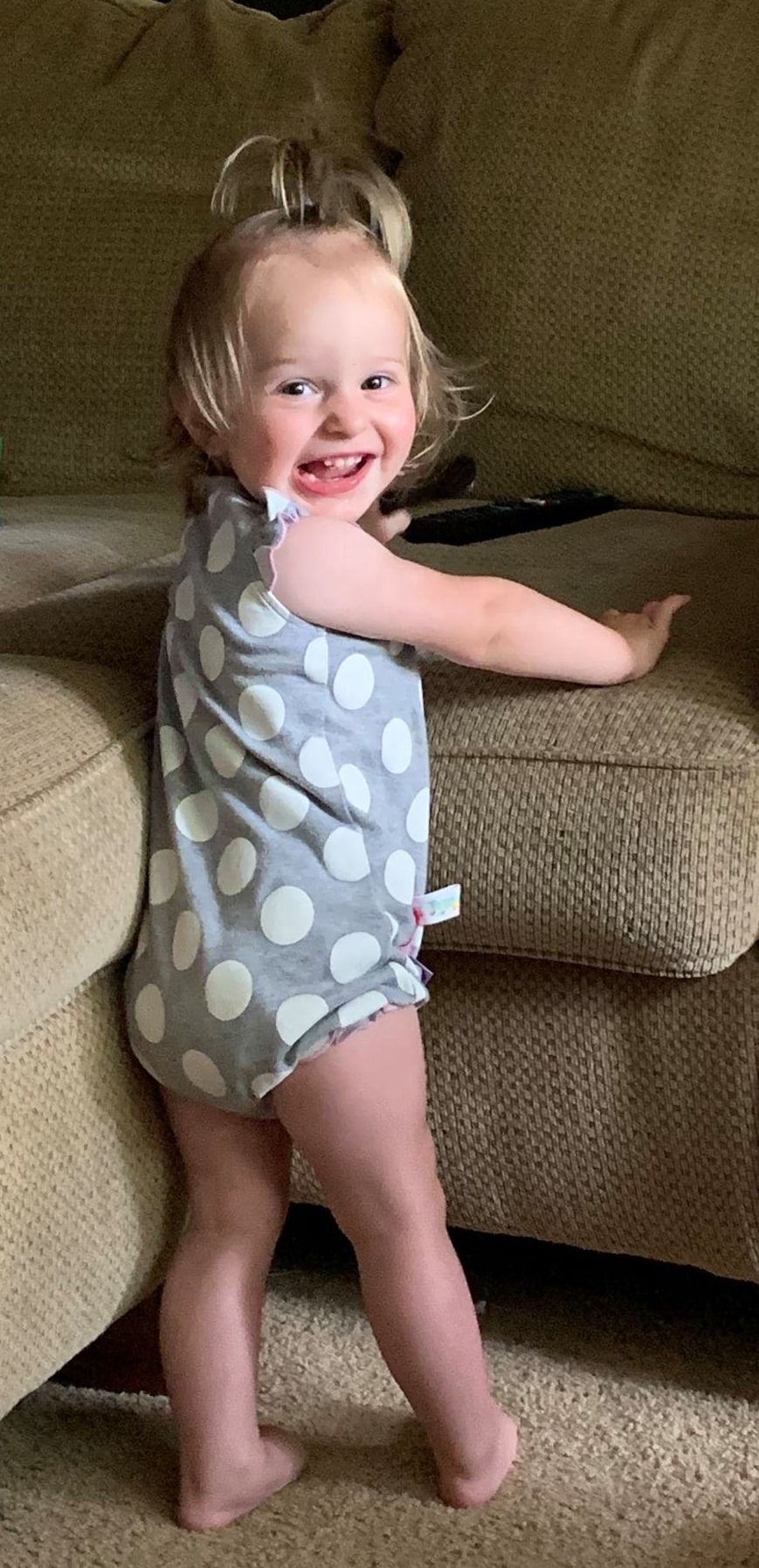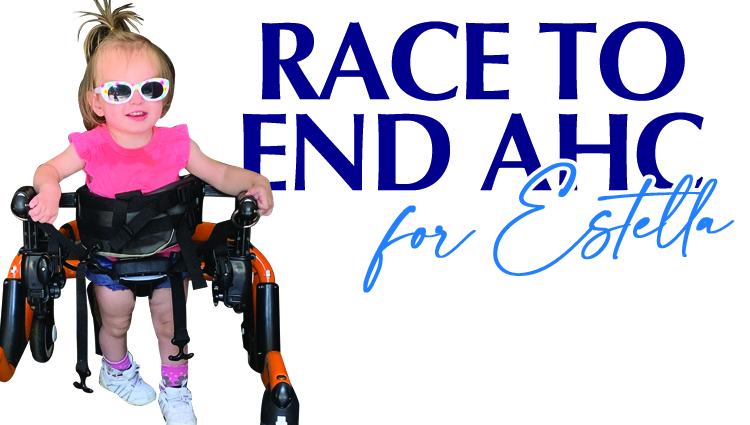Beautiful, brown-eyed Estella Henderson will soon be blowing out two candles on her birthday cake on Oct. 13. Since her arrival two short years ago, her family has felt a sense of joy like they’ve never experienced, along with a heavy dose of fear as they have learned to live life with Estella’s diagnosis of Alternating Hemiplegia of Childhood (AHC). Family and friends have joined forces to Race to End AHC for Estella on Sunday, Oct. 4, and are asking for your monetary support as they log the miles. First, learn more about this sweet child of God whose days are filled with so much love, but also so much uncertainty due to AHC.
Nearly two years ago, Lacey Henderson described her life as “perfect.” Lacey is the daughter of Denny and Georgia Slings of rural Newton. She attended Sully Christian School through eighth grade and graduated from Pella Christian High School, which is where she met her husband, Pella-native Stephen Henderson. Following graduation from Trinity Christian College, Lacey and Steve married. After three years of marriage, the couple started their family and welcomed Elena, William, Adriana, and Estella over the course of nine years. Life was so, so good.

Estella, held by her mother Lacey, is surrounded by her biggest supporters and advocates, her family: Left to right, Elena, Adriana, Lacey holding Estella, William, and Steve. The Hendersons are rallying family, friends, and supporters to Race to End AHC for Estella.
Feb. 26, 2019, the perfect life as the Hendersons knew it took a dramatic turn. Four-month-old Estella, who had been meeting all of her milestones up until that time, started acting strangely. “Her right eye was pulled almost backwards, her head was stuck over her right shoulder, and although she was breathing, she was otherwise unresponsive,” recalls Lacey. The fearful parents rushed their baby to the emergency room, then were taken by ambulance to Blank Children’s Hospital. After several tests that came back normal, they were sent home with more questions than answers.
This frightening scenario played out five more times over the course of five weeks. The Hendersons spent most of March 2019 in the hospital desperate for answers for their little girl. Memories of that time revolve around blood draws, MRIs, CAT scans, EEGs, sleepless nights, tears, and frightened phone calls. “I have memories of watching ER staff prepare crash carts and oral airways, of ER doctors telling me they expect her to stop breathing at any moment. Memories of stroking her cheek and saying goodbye. Memories of pleading with God for relief from this nightmare. Memories of wishing for something, anything, to show up on a test so we know what is going on,” said Lacey of that tumultuous month.
The Hendersons were finally given the diagnosis of intractable seizures. Those seizures would take over Estella’s body anywhere from 25 minutes to over two hours. When the symptoms would start, the Hendersons would rush Estella to the nearest emergency room, and her little body would be pumped with doses of Ativan over and over again. “We would hold her, completely and utterly helpless,” said Lacey.
Finally, results of Estella’s genetic testing done weeks prior were delivered to Lacey via a phone call on her way home from work in May 2019. Doctors informed Lacey that Estella had a De Novo mutation on the ATP1A3 gene. Neither Steve or Lacey are carriers of this mutation, but rather doctors explain it was a random event that happened at conception. This mutation and AHC diagnosis is an ultra-rare neurologic disorder that affects one in one million people. The disease causes episodes of paralysis, dystonia, nystagmus, decreased level of consciousness, intellectual disabilities, behavior disorders, gait abnormalities, and movement disorders. The diagnosis was devastating and the “poor prognosis” even harder to comprehend. “It’s a disease that is robbing my child of her life,” said Lacey. Estella’s future was and continues to be unknown, but at the time of diagnosis and now, the Hendersons were sure of one thing – they loved their baby girl immensely, her siblings and extended family were smitten with her, and they would do anything and everything to give her – and the entire family – a wonderful life.
Steve and Lacey’s first steps were to connect with professionals in the field of AHC. Estella and her parents flew to Durham, NC, in September 2019 and met with one of only a few AHC doctors in North America at Duke University. “Duke has an entire AHC clinic, and they are a God-send to our family,” said Lacey.
Four days after learning more about AHC, Estella had her first hemiplegic episode. This caused her to lose function of one or both hands for the next seven weeks.
Living with AHC
Today, the Hendersons and Estella have lived a year with hemiplegic episodes. Estella’s number of episodes are increasing, enduring one at least every two weeks. Some of the episodes can be long, some short. Sometimes Estella has small episodes daily. The short episodes last minutes or hours, and the family has no warning when one will appear. Long episodes can stretch out three to four days.
 “Every day we wake up and have no idea what the day will bring. Is AHC going to stay away and let us keep our baby the entire day? Or is an episode going to show up, unannounced, and steal her away from us? If so, for how long? Minutes, days, weeks? Will today be the day an episode leaves her with permanent damage? Is AHC going to take her away from us, forever?” explained Lacey of the questions that are constantly on the surface of their daily thoughts.
“Every day we wake up and have no idea what the day will bring. Is AHC going to stay away and let us keep our baby the entire day? Or is an episode going to show up, unannounced, and steal her away from us? If so, for how long? Minutes, days, weeks? Will today be the day an episode leaves her with permanent damage? Is AHC going to take her away from us, forever?” explained Lacey of the questions that are constantly on the surface of their daily thoughts.
Lacey explains the AHC episodes vary in their presentation, duration, and consistency. Sometimes Estella has rapid eye movement, or nystagmus, for a couple of minutes. Steve and Lacey have determined this side effect is triggered by changes in light or rapid movement. Sometimes AHC presents itself in the form of painful contractions of the limbs, called dystonia. “This is hard to deal with because she screams from the extreme pain this causes,” said Lacey. When dystonia cripples their daughter, Steve and Lacey stretch or massage the affected area. “I think that is more to make ourselves feel like we are doing something that can help,” said Lacey. Paralysis, or hemiplegia, is another symptom Estella experiences during episodes. There is no rhyme or reason as to what area of the body is affected – arms, legs, neck, or all. Estella has had two episodes that hemiplegia caused paralysis of both arms, both legs, and her neck, leaving only eye movement. Sometimes the symptoms change mid-episode. All of these crippling symptoms are hard to handle, but the decreased levels of consciousness prove to be hardest and most heartbreaking for Lacey to personally handle. “This is when I truly feel that AHC is stealing my baby from me,” she said.
AHC has robbed Estella, as well as the rest of the Henderson family, of so much. The Hendersons no longer have a so-called normal life, but rather rely on a lifestyle heavily dependent on routine and a watchful eye. Strict bedtimes and nap schedules are the new norm. The couple is careful not to take Estella outside when it’s too hot or cold, too sunny or windy, as any of those factors can trigger an episode. Estella cannot overexert herself, be near loud noises, or laugh too hard for too long as those simple, everyday experiences may also be the prelude to an episode. “She can’t swing in a swing. She can’t take a bath without us worrying it will put her into an episode. Sometimes something as simple as being in her carseat or highchair triggers an episode,” said Lacey.
Despite all that has been taken from them in terms of a “normal” life, the Hendersons say Estella’s diagnosis has also given them unexpected gifts. Those gifts have come in the form of Estella’s good days. “Estella’s good days are really, really good,” said Lacey. The family is no longer bothered by small, petty things that may have been an issue pre-diagnosis. “We are learning what is really important in this life. We are trying to hold her with open hands, knowing that this life is not the end of her story. We are living with the resurrection hope that one day all things will be made new and right again,” said Lacey.
Hope on this side of heaven
The Henderson family has been on a roller coaster for the past two years, a ride that has been simultaneously full of highs and lows, joy and tears, and hope and fear. These are intense emotions driven by an even more intense and consuming love for their little brown-eyed beauty. When first diagnosed, there was no treatment or cure for Estella. Now, researchers are working towards a cure, giving the Hendersons a little hope on this side of heaven. “A cure, a glimmer of hope, a small light in our darkness,” said Lacey of the new research. During an international symposium for AHC parents just two weeks ago, Dr. Mohamad Abdul Mikati, a leading AHC doctor, explicitly said, “It’s not a matter of if, but when we cure this disease.” Doctors and researchers believe there is a viable option through gene therapy, the same kind of therapy that has cured SMA and is currently curing genetic blindness, Duchenne Muscular Dystrophy, and Sickle Cell Anemia. Researchers are actively working to get a human clinical trial by 2022. It’s a breakthrough the Hendersons desperately yearn for and one they are seeking your assistance for to help push progress ahead.
Research of this magnitude doesn’t come cheap, and advocates for AHC therapy cannot get the attention of the National Institute of Health until therapy is proven effective. That is why the Hendersons, along with other families of AHC children desperate for help, are on a mission to raise money for their cause. Most of the money already donated for AHC awareness has been raised by the families of AHC children. These families are stressed and stretched thin, some in financial straits due to lost incomes because of the demands of AHC. “We have been told that all that stands between us and a cure is money. When I say there is no donation too small, I mean that. Every dollar helps us fight this awful disease. We continue to humbly ask you for donations to help end this disease and give our children a chance at a life unaffected by AHC,” said Lacey.
One million steps to a cure
Since the age of four months, Estella has been running a hard race. Now, family and friends are asking you to run alongside her and support the race for a cure. On Sunday, Oct. 4, Steve will be running along with friends Matt and Rachel Van Maanen in the Alternating Hemiplegia of Childhood Foundation’s RACE TO END AHC: A MILLION STEPS TO A CURE virtual event. Steve, Matt, and Rachel will each take turns running along a 5K route for a total of 26.2 miles. Friends and family have already given so much for the cause, sponsoring each mile they will run with generous monetary donations and a whole lot of prayer. Steve and Lacey originally set their fundraising goal at $30,000. They have been blown away by the magnitude of family and friends who have already pledged $24,417.78 as of press time. Now, they are hoping with your support they can blow that $30,000 goal out of the water and raise even more for the joint mission of ending AHC. Anyone who is interested in donating may give directly by clicking on the link https://ahckids.z2systems.com/estellah. Checks can be mailed to Stephen and Lacey Henderson at 285 240th Place, Pella, IA 50219. Donations may also be received through the website www.ahckids.z2systems.com, and a donation receipt will be sent to you.
All proceeds from the Race to End AHC will assist the Alternating Hemiplegia of Childhood Foundation in fulfilling its mission to end AHC. It’s a long race but one that is worth competing in. Steve, Lacey, and their family lace up their shoes every day to run alongside Estella and are grateful to everyone who joins them. “Thank you, this little girl means the world to us,” said Lacey.



